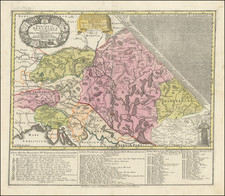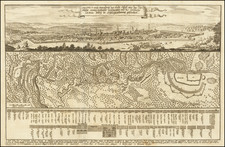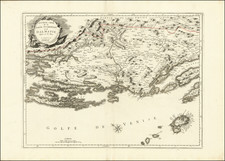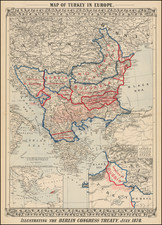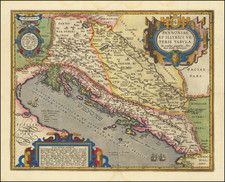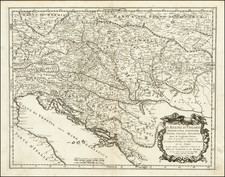The Rarest Lafreri Map of Dalmatia
Martino Rota's masterwork mapping of his home region (covering Zara to Sibenik), the second published map of the region, following Pagano's unobtainable map of the region, published circa 1530.
While the cartography is innovative and significant for the region, it is the decorative elements at the bottom of the map that make the work truly stand out among its Lafreri School contemporaries. In the lower right is a mass of galleys and square-rigged ships, centered on a ferociously rigged vessel complete with anchors and grappling hooks advancing upon the viewer. In the lower left is a lion (almost certainly the Lion of St. Mark, representing Venetian control over the region) defeating a dragon in battle. These decorative elements perfectly follow the style of Lafreri School cartography, but it is extremely rare to see such a focus on these elements and to see them engraved to such an impressive standard.
The cartography is based on the Pagano map but includes substantially more information, particularly in the morphology of the long, thin islands that characterize the region. Bifolco and Ronca hypothesize that Rota had access to manuscript cartographic charts from his home region. Given the extent of the corrections and the basic nature of the Pagano map in regard to coastal topography, this is likely to be the case.
The map also preserves local history, showing battles and naming local military commanders. Just outside the walled city of Zara (today Kir), the Capitanio Michel Lucih and the Capitanio Sladoie do battle. In 1570, Zara had just recently been refortified by the Venetians, who feared an Ottoman incursion into the area. Throughout the map, additional delightful scenes can be identified, like the twelve hill towns of the northeast or the Roman ruins near Briberio.
Martino Rota
The work finely displays Rota's skills as an engraver. While Rota composed a few maps and views, he primarily adapted compositions from other artists. His most famous work was an engraved issue of Michelangelo's The Last Judgment, and he also composed a number of important portraits of European leaders. His appreciation of subject matter and understanding of nature are eminently visible on the present map.
Rota was born in c. 1529 in Sibenik (Sibenico, to the far right of the map) and was active as an engraver in Venice, Rome, and Vienna.
Rarity
The map is extremely rare on the market. We were unable to locate any examples at auction or in dealer records.
Tooley located 5 examples in his census of Lafreri atlases.
The Lafreri School is a commonly used name for a group of mapmakers, engravers, and publishers who worked in Rome and Venice from ca. 1544 to 1585. The makers, who were loosely connected via business partnerships and collaborations, created maps that were then bound into composite atlases; the maps would be chosen based on the buyer or compiler’s interests. As the maps were initially published as separate-sheets, the style and size of maps included under the umbrella of the “School” differed widely. These differences can also be seen in the surviving Lafreri atlases, which have maps bound in with varying formats including as folded maps, maps with wide, trimmed, or added margins, smaller maps, etc.
The most famous mapmakers of the School included Giacomo Gastaldi and Paolo Forlani, among others. The School’s namesake, Antonio Lafreri, was a map and printseller. His 1572 catalog of his stock, entitled Indice Delle Tavole Moderne Di Geografia Della Maggior Parte Del Mondo, has a similar title to many of the composite atlases and thus his name became associated with the entire output of the larger group.









